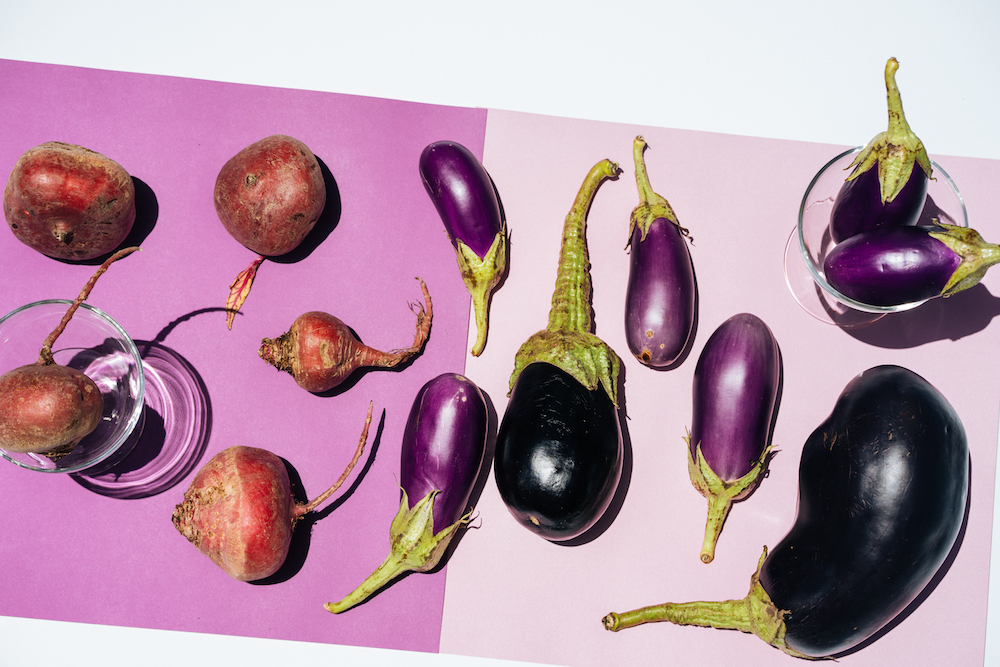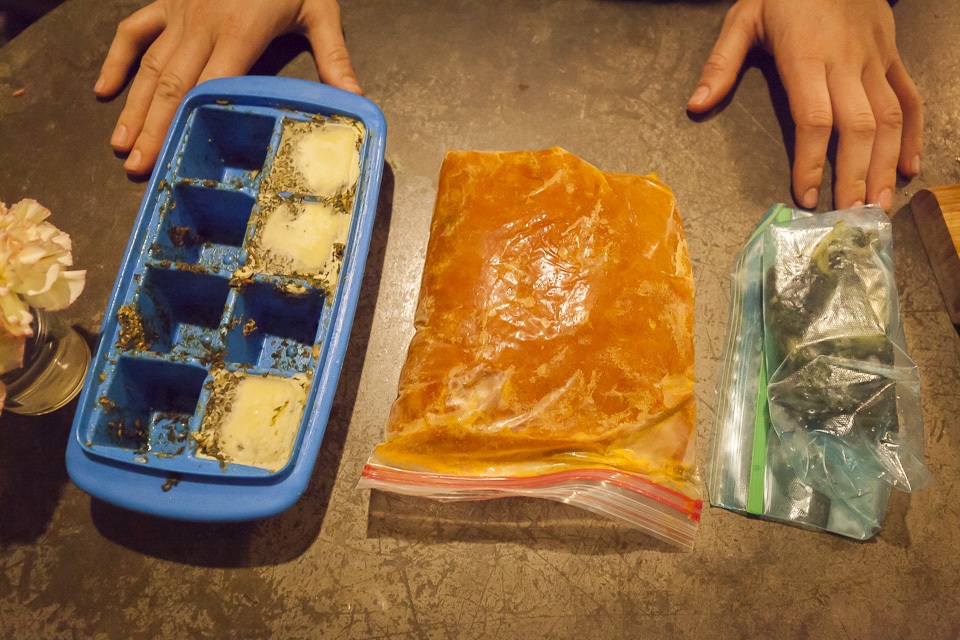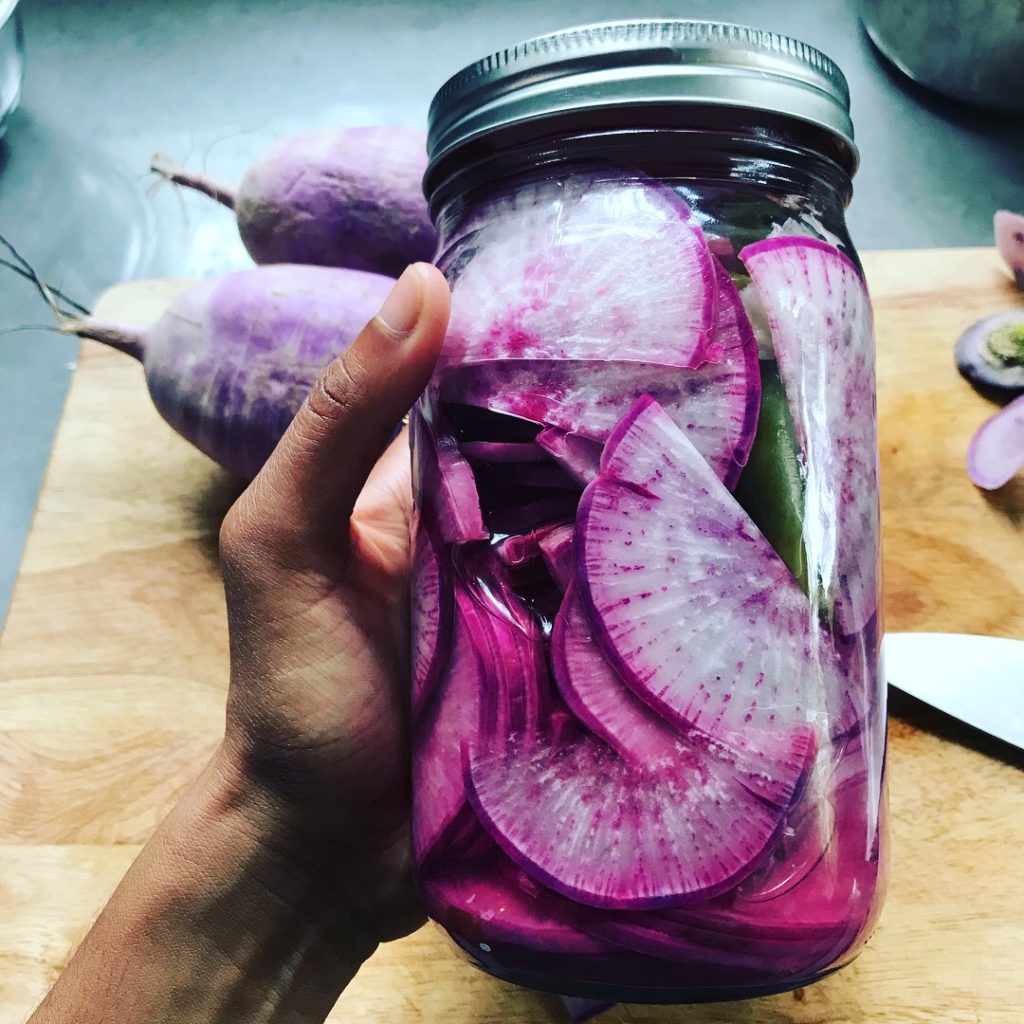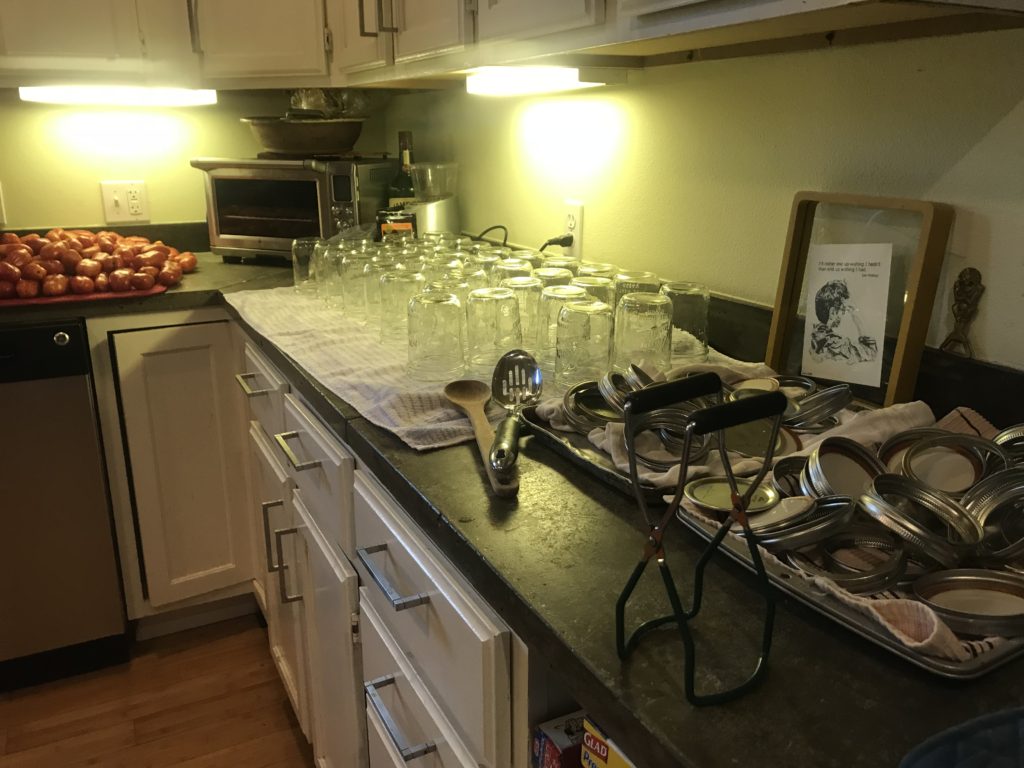
HOW TO MAKE YOUR VEGGIES LAST: LONG TERM STORAGE TIPS
04/26/19 — Heydon Hatcher
We published a piece a little over a year ago covering how to effectively process your produce in order to ensure its longevity (here). This week, we’re following up with a post about how to lengthen the seasons, or in other words, utilize long term storage in the kitchen! We’re talkin’ freezing, dehydrating, quick pickling, canning, and fermenting! The benefits of long term storage are not only increasing the life of your produce but preserving and extending the season. You may be sick of something now because it's abundant, but you can always save it for later when you are aching for those spring crop darlings. Additionally, long term storage avoids waste. Throwing those beautiful, unused radishes into the compost bin brings a tear to everyone’s eyes; however, if you have too much radish bounty, you can store and save them for later. You’ll be grateful when you are in another season and missing that tangy flavor! Finally, long term storing organic produce will certainly taste more flavorful than the store-bought versions. This year, replace off-the-shelf canned vegetables with local, organic, and home-made alternatives. Let’s get to it!
![]() Veggie gradient. Photo by Gillian Shewaga.
Veggie gradient. Photo by Gillian Shewaga.
Another worthy Ada tip: “Freeze other ingredients like freshly minced garlic and ginger paste, seasonal pesto, or tomato sauce. During tomato season: dedicate one lazy Sunday afternoon to hitting up the market, buying a bounty of tomatoes, and have nothing on your schedule except making and freezing tomato sauce.“ Check more of her freezer tips here.
![]() Frozen ingredients, ready to cook! Photo by Scott David Gordon.
Frozen ingredients, ready to cook! Photo by Scott David Gordon.
![]() Nadia's sweet and hot radishes. Photo by Nadia Tamby.
Nadia's sweet and hot radishes. Photo by Nadia Tamby.
Boiling water bath canning requires simple tools - you just need a larger pot with a rack at the bottom, jars, and tops (canning tongs are helpful, too!). You place the jars filled with food in boiling water for a specified time (depending on the recipe) and essentially as the jars cool a vacuum seal is created. Foods that can successfully be canned this way include pickled vegetables, preserves, and tomatoes with a little added acid (think - vinegar, citrus, or citric acid). Check out this delicious recipe for canning tomatoes here by our recipe developer, Megan Winfrey!
Pressure canning requires more specialized equipment, namely a pressure canner. This method gets the jars hotter than the temperature of boiling water which is important for certain kinds of veggies. Alkaline or low acid must be processed in a pressure canner in order to rid the food from dangerous bacteria. Canning really opens up a world of preserving seasons - think of all the jams, sauces, salsas, preserves, pickles! It's truly an amazing and fruitful technique - get to it! Here are some canning ideas to peruse. You'll have some amazing tastes in the pantry for months to come.
![]() Ada's tomato canning extravaganza last summer. Photo by Ada Broussard.
Ada's tomato canning extravaganza last summer. Photo by Ada Broussard.
Fermenting is relatively easy and is another very nutritious way to utilize veggies. Fermented recipes often keep for months in the fridge. Check out our recipe developer, Megan’s sauerkraut with fennel recipe here, it has a great rundown of the fermentation process.
Long term storage rules! We can’t wait to utilize some of these awesome techniques this weekend.
The Hip Girl’s Guide to Homemaking is a cookbook written by local Austinite and Texas Farmers' Market director, Kate Payne. There are lots of pickling recipes in here!
The Art of Fermentation by Sandor Katz, this is the bible of fermentation.
Lots of folks locally are occasionally doing classes on pickling. Check out Club Home Made, Maggie Perkins, Kitchen Underground.
Pickling and fermentation have been around for a LONG TIME. It helped preserve food before refrigeration. Think globally when looking for pickling or fermented recipes. Japanese and Korean cultures, for example, have a rich history of fermentation, and the internet is full of info, recipes, and resources.
 Veggie gradient. Photo by Gillian Shewaga.
Veggie gradient. Photo by Gillian Shewaga.
FREEZING
Most fresh vegetables should be blanched before freezing. This will kill the enzymes naturally present on the plants, and stop any further degradation in the freezer. Dry veggies thoroughly before putting in the freezer. Selecting produce at its peak freshness is vitally important to this process, and always store in airtight containers or freezer bags. Remove as much air as possible from your packages! Consider dating packages in order to keep track, too. Like master home chef, Ada Broussard, says in her post last week: “Do yourself a favor, and label what you put in the fridge. Even if you think you'll remember, just stick a label on it. Because the more you start to use your freezer, the crazier it will get in there. Include the date. I try to eat frozen leftovers in about 4 months, and try to use up frozen vegetables/ingredients in about 7 months. Of course, the food will likely still be fine past these dates, but you'll start to lose flavor and texture.”Another worthy Ada tip: “Freeze other ingredients like freshly minced garlic and ginger paste, seasonal pesto, or tomato sauce. During tomato season: dedicate one lazy Sunday afternoon to hitting up the market, buying a bounty of tomatoes, and have nothing on your schedule except making and freezing tomato sauce.“ Check more of her freezer tips here.
 Frozen ingredients, ready to cook! Photo by Scott David Gordon.
Frozen ingredients, ready to cook! Photo by Scott David Gordon.
DEHYDRATING
A fancy dehydrator is great, but you can also use your oven. It’s just as effective and you probably already have one! Here’s a recipe for oven-dehydrated tomatoes. After you dehydrate these, freeze in between layers of parchment paper in a sealed Tupperware for up to 8 months. For a shorter term take on delicious oven-dehydrated produce, here’s a delectable recipe for kale chips. These will keep for about a week, but good luck not eating all of these fresh out of the oven. These chips are amenable to any seasonings you have in the kitchen that you are keen to use.QUICK PICKLING
Do yourself a favor and learn how to do this if you haven’t already. As the name implies, this is QUICK and is the best way to use some surplus root crops like carrots, beets, and radishes. We love quick pickled onions and squash to top sandwiches and tacos. Peppers will be here soon, and both hot and sweet peppers make a delicious pickle, as well. Think pickled peppers on that favorite juicy summer hamburger (or veggie burger)! YUM! The uses are truly endless once these veggies take on their new tangy and sometimes sweet pickled taste, they are perfect for snacking, augmenting charcuterie boards, or even a side dish! Our recipe developer, Nadia Tamby, has a great rundown of the joys of sweet and hot radish pickles here and our pickling champion, Megan Winfrey, has a couple of mind-blowing recipes here and here. Nadia's sweet and hot radishes. Photo by Nadia Tamby.
Nadia's sweet and hot radishes. Photo by Nadia Tamby.
CANNING
Canning is a wonderful skill to have and an excellent way to extend the seasons. There are two different processes when it comes to canning: boiling water bath and pressure canning.Boiling water bath canning requires simple tools - you just need a larger pot with a rack at the bottom, jars, and tops (canning tongs are helpful, too!). You place the jars filled with food in boiling water for a specified time (depending on the recipe) and essentially as the jars cool a vacuum seal is created. Foods that can successfully be canned this way include pickled vegetables, preserves, and tomatoes with a little added acid (think - vinegar, citrus, or citric acid). Check out this delicious recipe for canning tomatoes here by our recipe developer, Megan Winfrey!
Pressure canning requires more specialized equipment, namely a pressure canner. This method gets the jars hotter than the temperature of boiling water which is important for certain kinds of veggies. Alkaline or low acid must be processed in a pressure canner in order to rid the food from dangerous bacteria. Canning really opens up a world of preserving seasons - think of all the jams, sauces, salsas, preserves, pickles! It's truly an amazing and fruitful technique - get to it! Here are some canning ideas to peruse. You'll have some amazing tastes in the pantry for months to come.
 Ada's tomato canning extravaganza last summer. Photo by Ada Broussard.
Ada's tomato canning extravaganza last summer. Photo by Ada Broussard.
FERMENTING
Fermentation is when microorganisms like bacteria or yeast convert carbohydrates into alcohol or organic acids under anaerobic circumstances. It's an easy process that has been culturally ubiquitous for centuries and makes amazing products like kefir, kombucha, miso, kimchi, sauerkraut, tempeh, and yogurt. With wide-ranging benefits from increased digestion and bioavailability of nutrients to reduced social anxiety, fermented foods combat against pervasive diseases like cancer, arthritis, and liver disease. These foods are chock-full of healthy bacteria, or probiotics, that reinforce the good bacteria in your gut, and in turn, improves your immune system (fun fact: 80% of your immune system is in your gut!).Fermenting is relatively easy and is another very nutritious way to utilize veggies. Fermented recipes often keep for months in the fridge. Check out our recipe developer, Megan’s sauerkraut with fennel recipe here, it has a great rundown of the fermentation process.
Long term storage rules! We can’t wait to utilize some of these awesome techniques this weekend.
Some of our Favorite Resources:
We love the USDA's complete guide to canning. food safety is a concern when preserving food for long-term use, and though it may be a bit overkill, this guide covers IT ALL.The Hip Girl’s Guide to Homemaking is a cookbook written by local Austinite and Texas Farmers' Market director, Kate Payne. There are lots of pickling recipes in here!
The Art of Fermentation by Sandor Katz, this is the bible of fermentation.
Lots of folks locally are occasionally doing classes on pickling. Check out Club Home Made, Maggie Perkins, Kitchen Underground.
Pickling and fermentation have been around for a LONG TIME. It helped preserve food before refrigeration. Think globally when looking for pickling or fermented recipes. Japanese and Korean cultures, for example, have a rich history of fermentation, and the internet is full of info, recipes, and resources.






 0 ITEMS IN CART
0 ITEMS IN CART 

